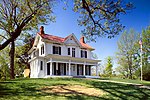The White House Visitors Office is responsible for public tours of the White House, for maintaining a facility where the public can obtain information about the White House, and for other White House events such as the White House Easter Egg Roll, Holiday Open Houses, Spring and Fall Garden tours, State Arrival Ceremonies and other special events.
The White House Visitor Center, which is managed and operated by the National Park Service, is located within President's Park at the north end of the Herbert C. Hoover Building (the Department of Commerce headquarters) between 14th Street and 15th Street on Pennsylvania Avenue NW, in the Federal Triangle. Since September 11, 2001, it no longer serves as a starting point for those going on a reserved tour of the White House. Instead, the various exhibits within it provide an alternative visitor experience for those not able to go on a tour. The themes of the six permanent exhibits are "First Families", "Symbols and Images", "White House Architecture", "White House Interiors", "Working White House", and "Ceremonies and Celebrations". Other exhibits change throughout the year. It houses a small bookstore operated by the White House Historical Association.
The visitors office is located in the East Wing of the White House and employed seven people at the start of the 2000s. Its role has been unique in that, up to 2001, the White House was the only home of a head of state that was regularly open to the public at no cost.
The director of the White House Visitors Office has been termed in media accounts as "the most powerful person in Washington that you've never heard of."









